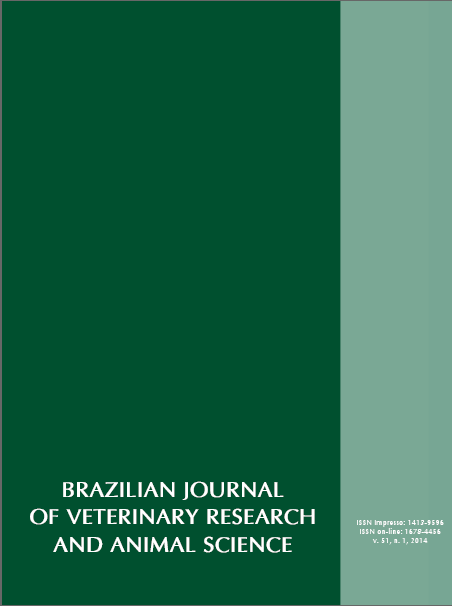Perfil de ocitocinea central e periférica em ovelhas lactantes
DOI:
https://doi.org/10.11606/issn.1678-4456.v51i1p68-77Palavras-chave:
Cateterização, Ejeção, Líquido cefalorraquidiano, Ovelha, LactaçãoResumo
Foi investigada a possível relação entre as concentrações de ocitocina no líquido céfalo-raquidiano e no soro em diferentes formas de ordenha em ovinos. Foram utilizadas dez ovelhas multíparas divididas em quatro grupos de acordo com o estímulo para ejeção do leite: ordenha exclusivamente mecânica (EM), ordenha mista mecânica e mamada com os carneiros separados das mães durante a noite e reunidos a elas pela manhã para amamentação (MMS); ordenha mista com ordenha manual (MMS); apenas amamentação natural (ES). Foram coletadas amostras de fluido cerebroespinhal e de sangue simultaneamente durante as ordenhas. A média, coeficiente de variação e valores máximos e mínimos de ocitocina do plasma foram respectivamente 257,88 ± 265,90 pg/ml, 103,11%, e 11,70 e 1000,00 pg/ml. Não foram encontradas correlações entre as concentrações centrais e plasmáticas de ocitocina (EM: -0,26; ES: -0,19; MMM: 0,05; MMS: 0,04). Não foi evidenciada influência do tipo de estímulo para ejeção do leite nas concentrações centrais de ocitocina. Entretanto, as concentrações plasmáticas de ocitocina foram maiores nos grupos MMM (679,80 ± 25,63) e MMS (591,82 ± 30,56) quando comparadas as dos grupos EM e ES. Alem disso, as concentrações plasmáticas de ocitocina foram maiores no grupo de OME (381,04 ± 22,09) em relação ao grupo AE (218,82 ± 27,04). Os resultados obtidos sugerem que as concentrações plasmáticas de ocitocina são mais sensíveis ao tipo de ordenha que as concentrações centrais desse hormônio.
Downloads
Downloads
Publicado
Edição
Seção
Licença
O conteúdo do periódico está licenciado sob uma Licença Creative Commons BY-NC-SA (resumo da licença: https://creativecommons.org/licenses/by-nc-sa/4.0 | texto completo da licença: https://creativecommons.org/licenses/by-nc-sa/4.0/legalcode). Esta licença permite que outros remixem, adaptem e criem a partir do seu trabalho para fins não comerciais, desde que atribuam ao autor o devido crédito e que licenciem as novas criações sob termos idênticos.





